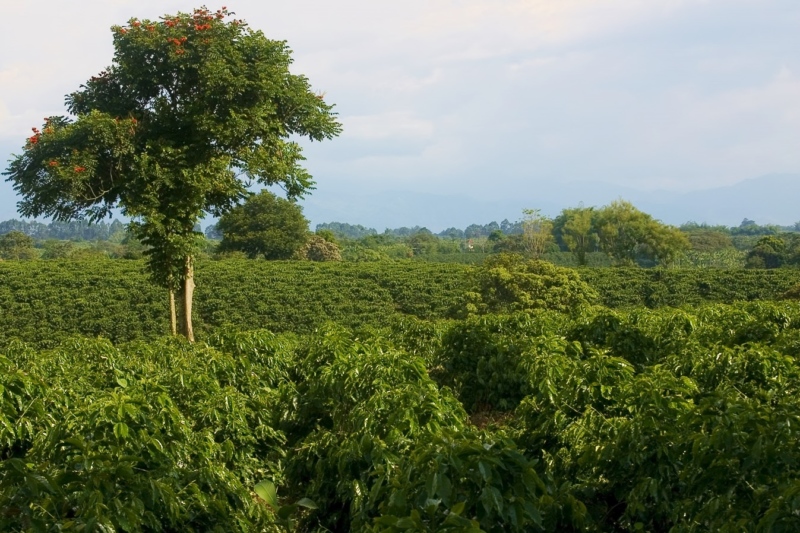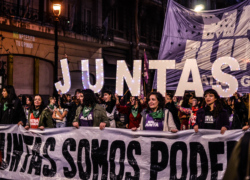Latin America Advisor
A Daily Publication of The Dialogue
Will a Peace Deal Allow Colombia to Grow More Food?
 A coffee plantation near Quimbaya in Quindío, Colombia.
A coffee plantation near Quimbaya in Quindío, Colombia.
Days after the Colombian government and the FARC rebels announced they had reached final peace accords, Post-Conflict Minister Rafael Pardo outlined a plan for new economic incentives for development as well as $400 million in investment in rural areas that were left largely undeveloped during the 52-year armed conflict. The government estimates that only 30 percent of the country’s food production capacity is being utilized. What does the proposed peace deal mean for Colombia’s food production? How will expected transformations in Colombia’s rural areas, coupled with recent free trade agreements, change Colombia’s agricultural sector? Will Colombia, which experienced prolonged transport strikes this year and violent farmer protests in 2014, have enough stability for investors and workers to see growth in the agricultural sector in the medium and long term?
Devry Boughner Vorwerk, member of the Advisor board and senior policy advisor at Akin Gump: "Agriculture and rural development was the first pillar of the accord and took much negotiation to achieve agreement. Getting agriculture development right allows Colombia to chart a unified pathway toward greater peace and prosperity. The agreement itself sets the stage for increased competitiveness of the Colombian farmer and of the broader food and agriculture sector. Colombia is a current net importer of food, yet has the potential to increase local production significantly to provide for its own food security needs, and in the future, possibly the needs of the broader Latin American region. At the heart of the agreement is access to land, and ensuring land rights for small holders and legalizing land ownership titles more broadly. Providing clarity on land rights is critical to agriculture development, no matter what country. A farmer needs to know that if s/he invests in her/his land, that those investments are protected. Elsewise, the farmer has no incentive to spend his/her limited capital on upgrades. Land rights ensure farmers can reap the benefits of those upgrades. The reality is that it will take significant investment in the rural areas in Colombia to upgrade agriculture and to prepare the land so that it can achieve its production potential. Much of the areas that are ripe for increased production (e.g., Vichada) require significant investment to bring the soil quality to a point at which agriculture can thrive. It is a positive (and necessary) offering by the Colombian government to deploy $400 million dollars into rural areas. That investment needs to be matched by private sector investment in everything from building roads to irrigation systems to physical distribution networks. One point that is critical to understand is that the post-conflict agriculture sector in Colombia will not take a one-size-fits-all approach. There are ways that Colombia can achieve successful outcomes in agriculture development by focusing on the small holder as well as by empowering production to scale. Striking that balance is critical to post-conflict success."
Verónica Navas Ospina, partner at EConcept in Bogotá: "Colombia, unlike Peru or Brazil, has been unable to produce an agricultural miracle. Investment in rural areas is scant, and agricultural production accounts for less than 6 percent of GDP. One of the many reasons behind Colombia’s meager agricultural production has been the presence of a five-decade-long armed conflict in remote rural areas. Hence, bringing peace to Colombia’s rural regions should represent a first step towards building a sustainable agricultural sector. However, it is unrealistic to expect this to happen soon. The peace agreement entails, as one of its pillars, an ambitious rural reform. The reform involves giving 3 million hectares of land to peasants, as well as formalizing land titles for 10 million hectares, in order to address the critical issue of property rights in rural areas. While formalizing property rights is badly needed, it will take a long time to implement. Giving land to peasants is equally difficult, as the government does not own this much land to give. Hence, property rights will remain uncertain for some time, which will make it difficult to attract private capital to make large-scale investments in rural areas. Promoting agricultural production requires many additional elements: road infrastructure, irrigation technology, technical capacity and access to credit, among others. The peace agreement mentions that government investment in such areas is a priority; however, the resources are not there, and the capacity to execute public investment at a regional level is poor. Putting an end to the conflict is a crucial milestone, but it will be a decade or so before this effort results in a world-class agricultural sector in Colombia."
Alejandro Reyes González, director of economic research at Ultraserfinco in Bogotá: "The starting point might be the most critical ally in the success of the development of agriculture in Colombia. We have not had a proper agricultural reform, resulting in ownership concentration and unproductive rural areas. This burden not only promoted violence by the guerrillas but also historical confrontations among Colombians. The agreement, which is basically an agricultural reform and a commitment by the establishment to invest in infrastructure in agricultural areas if developed in time and form, may lead to a growth revolution that is needed now more than ever in Colombia, due to the less fortunate days our oil industry is experiencing. But nothing can be taken for granted, and the process is most certainly rocky, especially with regard to private property and the transition to a pool of land that the government must constitute to later divide among peasants. Some of those territories have had a violent past either in the most recent exchange of ownership or in a prior one, on both. The government might expropriate those territories, but if it is not done properly, this might lead to a new era of violent reactions. On the second issue, the country has not excelled at developing proper infrastructure; there is abundant proof of this incapacity, and thus this poses a huge risk to a productive agricultural sector. In order to have a successful transition, the government must act swiftly and decisively. What has been agreed upon is needed, but this is not enough to flip a lagging productive sector into a new economic revolution. The industrial sector and a larger scale of production are needed, and these are not explicitly contained in the agreement. But at least this step tries to take distance from the status quo, which has unquestionably failed in Colombia."
Maria Velez de Berliner, president of Latin Intelligence Corporation: "In the FARC’s Zonas Veredales, such as Ituango/Dabeiba, where crop substitution is being tested, food production competes with cocaine’s profit chain. Colombia’s National Police estimates the same kilogram of cocaine at jungle gate costs $2,200, $7,000 at Colombian ports, $16,000 in Mexico, $27,000 wholesale in the United States, $55,000 in Europe, and $200,000 in Australia. Therefore, there is no profitability comparison between cocaine and a pound of coffee, at $1.40 placed in New York. Cocaine has a guaranteed labor force and effective demand, domestically and abroad. There are not enough workers to collect the current coffee crop, affecting supply. If the $400 million is to switch peasants from cocaine into legal food production, four improvements are mandatory in the countryside: 1) Expand the road network to reach the new agricultural areas so substitute crops can reach Corabastos and other wholesale distributors. These roads should have protective barriers against mudslides and falling rock that paralyze transport almost daily during the rainy season. 2) Establish refrigerated warehouses, at reasonable distances and costs. Agriculture without refrigeration loses its competitiveness. 3) The new producers must have guaranteed markets at the beginning. Corabastos and similar centers must receive incentives to facilitate the localization of the new products. 4) Security and safety against the predations of the Ejército Contra la Restitución must be immediate. The same must be done against the armies of auto-defensas being formed in the countryside. If the government can do this, there is hope that some peasants will switch to somewhat profitable agriculture, in relative safety and security, but cocaine will remain an attractive alternative."
The Latin America Advisor features Q&A from leaders in politics, economics, and finance every business day. It is available to members of the Dialogue's Corporate Program and others by subscription.



















